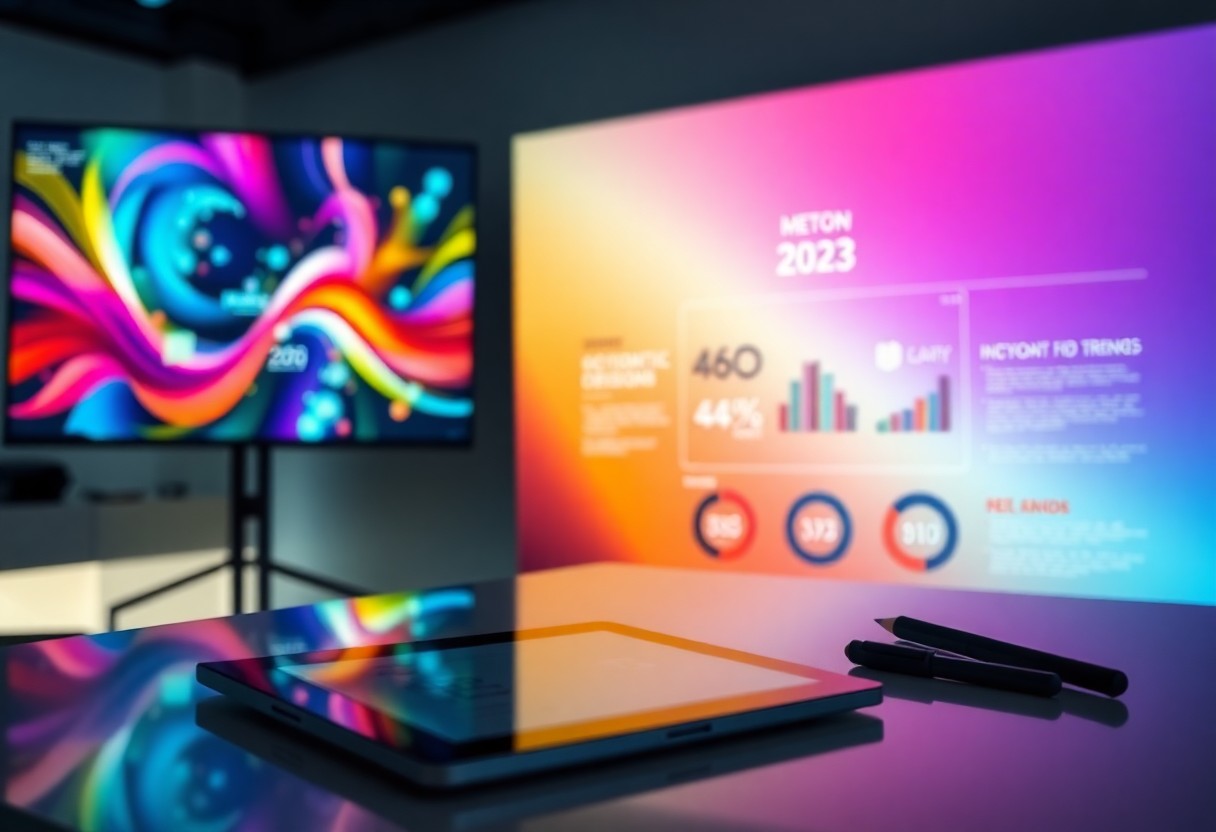Most digital marketers are aware that staying ahead of graphic design trends is crucial for creating impactful campaigns. In 2023 and beyond, understanding these trends can help you effectively engage your audience and enhance your brand’s visual identity. From the rise of minimalist design to the integration of immersive technologies, your ability to adapt to these trends will not only set you apart from competitors but also resonate deeply with your target market. Dive into this guide to explore the top graphic design trends you should embrace for successful marketing efforts.
The Visual Shift: Embracing Maximalism in Design
Maximalism is taking center stage in the world of graphic design, inviting marketers to celebrate complexity over simplicity. This exuberant approach encourages a bold mix of colors, textures, and patterns, creating vibrant visuals that captivate audiences. As you embrace maximalism, your designs can provide a sensory experience that stands apart from the minimalist aesthetics that have dominated recent years. This trend not only appeals to youthful demographics craving novelty but also challenges conventional design norms, empowering your brand to convey a more dynamic story.
Characteristics of Maximalism in Digital Marketing
Maximalism in digital marketing is characterized by bold typography, layered imagery, and a diverse palette of colors that evoke emotion. You’ll often see asymmetrical layouts and intricate designs that merge various graphic elements, inviting the viewer to explore every detail. This style encourages audience engagement through complexity, presenting a visual feast that makes your campaigns memorable. The emotional resonance created by maximalist designs can prompt stronger connections between your brand and your audience, effectively delivering your messaging in a vibrant, unpredictable format.
Case Studies: Brands Successfully Implementing Maximalism
Several brands have embraced maximalism with great success, showcasing how this trend can drive engagement and set them apart in competitive markets. Notable case studies demonstrate the effectiveness of this design approach through increased interaction rates and brand loyalty.
- Dr. Martens: Their 2022 campaign showcased a maximalist aesthetic with bold colors and eclectic patterns, resulting in a 25% increase in social media engagement compared to their previous minimalist campaigns.
- Wendy’s: The fast-food chain’s latest marketing materials feature vibrant artwork, collages, and quirky fonts, leading to a 30% boost in brand mentions across social platforms.
- Toyota’s “More Than Just A Car” Campaign: Utilizing colorful graphics and a mix of bold imagery, this campaign saw a 40% jump in interactions during its launch period.
- Adobe: Their marketing for Adobe Express included bright, playful graphics, achieving a 50% rise in user registrations in just one month following its release.
These successful implementations highlight the potential of maximalism to create distinct and memorable branding experiences. Each example illustrates how passionate engagement and visual richness can capture consumer attention, illustrating a marked difference in performance metrics when compared to more traditional, minimalist approaches. By studying these cases, your own marketing strategies can unlock the vast potential of maximalist design.
Color Psychology: Leveraging Bold Palettes for Engagement
Bold color palettes create an immediate visual impact, enhancing your brand’s identity and encouraging user interaction. Combined with effective design strategies, these attention-grabbing hues can evoke emotions that foster a deeper connection with your audience. By skillfully utilizing color psychology, you can create visuals that not only capture attention but also drive engagement and conversions in your marketing campaigns.
The Impact of Color on Consumer Behavior
Color significantly influences consumer behavior by eliciting emotional responses that can drive purchasing decisions. For instance, studies show that 85% of consumers make decisions based on color alone, associating specific hues with particular feelings and values. For example, blue often conveys trust and reliability, while red evokes excitement and urgency. Understanding these associations allows you to strategically select colors that resonate with your target audience, enhancing their overall experience and connection with your brand.
Trends in Color Choices for 2023 and Beyond
In 2023, expect to see a surge in vibrant and contrasting color combinations that make statements. Colors like ultra-violet and electric yellow are gaining traction, as marketers embrace the energy and dynamism they bring. Soft, muted tones paired with bold accents also create a striking balance, appealing to a wider range of consumers. The emphasis is on personalization, where brands experiment with unique palettes that reflect their identity and resonate with their audience’s values.
This year, brands increasingly opt for vibrant color pairings that command attention in a saturated digital landscape. Expect to see shades of emerald green, spicy orange, and hot pink featured prominently in marketing materials, creating standout visual footprints. Additionally, eco-friendly brands may lean towards earth tones, promoting sustainability through their color choices. As digital spaces evolve, experimenting with unexpected color combinations will not just be a trend but an necessary strategy for differentiation and connection in your marketing efforts.

Motion Graphics: Breathing Life into Static Content
As the digital landscape evolves, motion graphics have emerged as a powerful tool for capturing attention and conveying messages. By animating design elements, you can effectively breathe life into static content, making it more engaging and memorable. This trend is particularly valuable in marketing, where grabbing and sustaining viewer interest can lead to higher conversion rates and better audience retention.
The Growing Popularity of Animation in Marketing
With the rise of platforms like TikTok and Instagram Reels, animated content is gaining traction in the marketing world. Brands that utilize animation often see up to 1200% more shares than those using static images, as dynamic visuals tap into emotional responses and create a lasting impression. As consumers’ attention spans shrink, animations provide a way to communicate complex messages quickly and effectively.
Best Practices for Integrating Motion into Digital Assets
Incorporating motion into your digital assets can enhance storytelling, but it’s imperative to do so thoughtfully. Aim for seamless transitions that complement your brand’s identity. Keep animations brief and purposeful—research indicates that looped animations work best when kept under 10 seconds to avoid viewer fatigue. Also, consider aligning the movement style with your overall brand messaging; playful animations may resonate well with a youthful audience, while sleek, professional visuals better suit corporate sectors.
Utilizing motion graphics effectively entails balancing creativity with usability. Enhance user experience by ensuring animations do not distract or overwhelm; they should serve to guide the viewer rather than confuse. Implementing motion design in ways that harmonize with your content can amplify engagement without sacrificing clarity. Testing various formats and tracking audience reactions will enable continual refinement, optimizing your approach while aligning with overarching marketing goals.
Sustainable Design: The Eco-Conscious Approach
Sustainable design is no longer just a trend; it’s an imperative consideration for every digital marketer. As consumers increasingly prioritize eco-friendly practices, your graphic design choices can significantly influence their perception of your brand. By integrating sustainable elements into your visual strategies, you not only reduce environmental impact but also align your business with the values of a growing market segment that seeks responsible consumerism.
Why Sustainability Matters in Graphic Design
Opting for sustainable graphic design reflects your commitment to environmental stewardship and ethical responsibility. In a world grappling with climate change, utilizing eco-conscious practices elevates your brand’s image and can strengthen customer loyalty. Companies that prioritize sustainability often see an increase in brand affinity, as consumers gravitate towards businesses that share their values. This alignment drives not only engagement but also revenue growth.
Graphic Design Trends that Promote Environmental Responsibility
Innovative trends in graphic design emphasize eco-friendliness, including the use of recycled materials, digital-based promotions over print, and eco-conscious color palettes that inspire wellness. Designs featuring nature motifs, earthy tones, and minimalist aesthetics are increasingly popular, communicating a message of sustainability. Brands embracing these concepts often showcase their commitment to the environment, fostering a connection with like-minded consumers.
To illustrate the impact of sustainable design, consider the rise of brands like Patagonia, which utilizes recycled materials in their branding efforts and maintains a transparent supply chain. The minimalist approach is another effective trend, allowing your designs to communicate messages powerfully yet simply. By adopting practices such as using vector graphics that require fewer resources and promoting digital alternatives, your design strategy can reflect not only aesthetic values but also an eco-conscious ethos that resonates with today’s eco-aware consumers.
The Rise of Inclusive Design: Meeting Diverse Needs
Inclusive design focuses on creating experiences that accommodate users with varying backgrounds, abilities, and needs. This approach enhances usability and fosters a sense of belonging, ensuring that everyone, regardless of their physical or cognitive abilities, can engage with your brand effectively. As you implement inclusive design principles, you’ll not only expand your audience reach but also build stronger connections with customers who appreciate your commitment to diversity and accessibility.
Designing for Accessibility: Expanding Reach and Impact
Accessibility in design means your digital content is usable by everyone, including individuals with disabilities. By incorporating features such as screen reader compatibility, high-contrast visuals, and easy navigation, you ensure that your design meets diverse user needs. This not only enhances user experience but also significantly widens your market reach, allowing you to connect with a broader audience and drive positive engagement.
Examples of Brands Leading the Way in Inclusive Design
Several standout brands demonstrate excellence in inclusive design, setting benchmarks for others to follow. Nike, for instance, introduced the FlyEase shoe line, featuring a hands-free entry system for athletes of all abilities. Meanwhile, Apple has made significant strides by integrating accessibility features into their products, such as VoiceOver and customizable display settings. These companies not only enhance their user experience but also create a brand ethos centered around inclusion and equality.
Nike and Apple are not alone; other brands also prioritize inclusive design. Microsoft’s commitment to accessibility is evident through their innovative Adaptive Controller, designed for gamers with limited mobility. Similarly, Airbnb has instituted accessibility filters allowing users to search for spaces that meet their needs, ensuring travelers of all abilities can find accommodating lodging. These examples show how embracing inclusive design can redefine brand perception and customer loyalty while catering to an often-overlooked audience segment.
Conclusion
Ultimately, staying abreast of the top graphic design trends is vital for your success as a digital marketer in 2023 and beyond. By incorporating elements like bold typography, sustainable design, and immersive AR experiences, you can elevate your brand’s identity and create engaging content that resonates with your audience. Embracing these trends not only enhances your marketing strategy but also keeps your work fresh and relevant in an ever-evolving digital landscape. Stay informed and adapt these trends to your projects for optimal impact.

